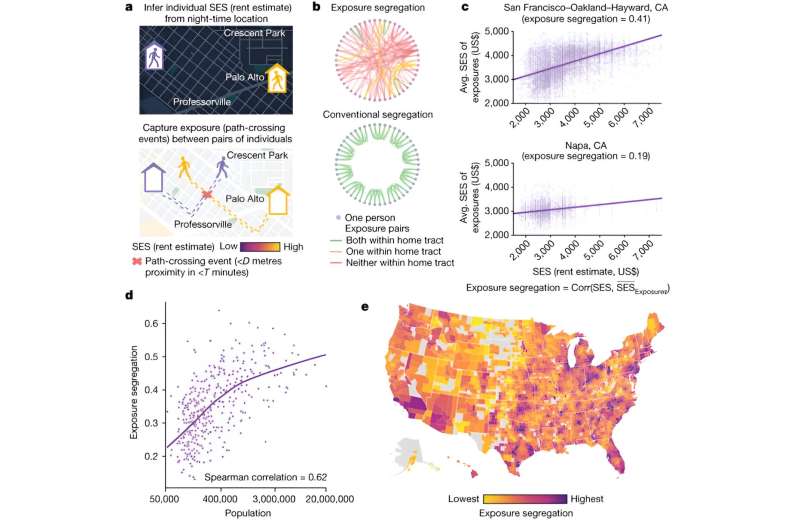This article has been reviewed according to Science X's editorial process and policies. Editors have highlighted the following attributes while ensuring the content's credibility:
fact-checked
peer-reviewed publication
proofread
Big cities foster socioeconomic segregation: Here's how we can fix that

We tend to think of large cities as melting pots—places where people from all sorts of backgrounds can mingle and interact. But according to new research, people in big cities tend to primarily interact with other individuals in the same socioeconomic bracket, whereas people in small cities and rural areas are much more likely to have diverse interactions.
Using cellphone data, a collaboration of researchers led by Stanford University determined that most people in big cities have very few opportunities for even brief interactions with those outside their own socioeconomic status. The results, published Nov. 29 in Nature, show that if we want cities to be the cosmopolitan mixing grounds we expect them to be, we need to make intentional urban design choices to encourage those interactions.
"As we become an ever more urban country, it's important to figure out whether big cities are living up to the long-standing assumption that they promote mixing and diversity," said David Grusky, the Edward Ames Edmonds Professor in the School of Humanities and Sciences. "Although income inequality remains extremely high, that doesn't mean that we also have to reconcile ourselves to highly segregated cities in which people who are rich never see or interact with those who are poor."
Few opportunities to meet
The researchers used GPS data collected in 2017 from 9.6 million cellphones across 382 metropolitan areas in the United States to determine how often people of different socioeconomic statuses crossed paths during the day—essentially how many times people had the opportunity to interact, even briefly, with someone in a different income bracket.
After inferring each person's socioeconomic status from estimated rental prices on a real estate marketing website, the researchers counted potential interactions between users over the course of the day—times where two cellphones had GPS pings within 50 meters of each other within a five-minute window. They collected data on almost 1.6 billion path-crossings.
This large amount of extremely precise data allowed the researchers to see a clear pattern that has been missed by similar studies in the past: large cities foster socioeconomic segregation. People living in the 10 most populous metropolitan areas, which include cities like New York City, Los Angeles, and Chicago, along with their surrounding areas, were significantly less likely to interact with people of different socioeconomic statuses than people in metropolitan areas with fewer than 100,000 residents.
"That seems like a counterintuitive observation," said Jure Leskovec, a professor of computer science. "But there is a large variety of choices in big cities. In New York, you can spend $10 on a dinner or $1,000 on a dinner, whereas if you live in a place with only one diner, everyone goes there, rich or poor. That seems to be the main mechanism for this phenomenon."
Designs that bridge neighborhoods
The good news is that there are ways to build cities to foster more socioeconomic mixing. Looking at large cities, the researchers found that those that placed frequently-visited hubs in between different neighborhoods—instead of in the center of each neighborhood—were less segregated.
"These big cities have managed to foster diverse interactions because the hubs that people visit the most—which turn out to be shopping malls, plazas, and similar places—are between rich and poor neighborhoods," said Hamed Nilforoshan, a doctoral student in Leskovec's lab and first author on the paper. "Those hubs act as bridges, allowing people to see each other and interact."
By providing a better understanding of how the location of public infrastructure can affect socioeconomic mixing, the researchers hope their work will assist urban planners in building cities that live up to the promise of fostering diverse interactions. Cities are constantly being rebuilt and redesigned, and this work could help ensure that those changes benefit everyone.
"We've long emphasized residential integration—and we're right to do so—but we now have a complementary way to mitigate socioeconomic segregation," Grusky said. "When new shopping centers and other activity hubs are up for approval, we need to make sure they're located in places that will promote diversity, not segregation."
Other Stanford co-authors of this research include research assistants Wenli Looi, Blanca Villanueva, Nic Fishman, Yiling Chen, and John Sholar. Other co-authors are from Cornell Tech and Northwestern University.
More information: Hamed Nilforoshan et al, Human mobility networks reveal increased segregation in large cities, Nature (2023). DOI: 10.1038/s41586-023-06757-3
Journal information: Nature
Provided by Stanford University School of Engineering




















